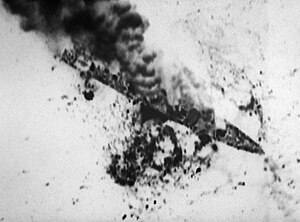
Back عملية فرس النبي Arabic آخوندک عملیاتی AZB Operation Praying Mantis German عملیات آخوندک Persian Bataille des plates-formes pétrolières Sassan et Sirri French Operacija Bogomoljka Croatian Operazione Praying Mantis Italian プレイング・マンティス作戦 Japanese 프레잉 맨티스 작전 Korean Богомол (операция) Russian
This article needs additional citations for verification. (March 2020) |
| Operation Praying Mantis | |||||||
|---|---|---|---|---|---|---|---|
| Part of the Iran–Iraq War | |||||||
 The Iranian frigate Sahand attacked by aircraft of U.S. Navy Carrier Air Wing 11 after the guided missile frigate USS Samuel B. Roberts struck an Iranian mine | |||||||
| |||||||
| Belligerents | |||||||
|
|
| ||||||
| Commanders and leaders | |||||||
|
|
| ||||||
| Strength | |||||||
|
1 aircraft carrier 1 amphibious transport dock 4 destroyers 1 guided missile cruiser 3 frigates AH-1T helicopters A-6E Intruder attack jets |
2 frigates 1 gunboat 6 Boghammar speedboats (estimated) 2 F-4 fighters ZU-23 guns on 2 platforms | ||||||
| Casualties and losses | |||||||
|
2 killed 1 helicopter crashed (cause unknown) |
1 frigate sunk (45 crew killed)[3] 1 gunboat sunk (11 crew killed)[3] 3 speedboats sunk 1 frigate crippled 2 platforms destroyed[4] 1 fighter damaged Total: 56 killed 5 ships sunk | ||||||
Operation Praying Mantis was the 18 April 1988 attack by the United States on Iranian naval targets in the Persian Gulf in retaliation for the mining of a U.S. warship four days earlier.
On 14 April, the American guided missile frigate USS Samuel B. Roberts struck a mine while transiting international waters as part of Operation Earnest Will, the 1987–88 effort to protect reflagged Kuwaiti oil tankers from Iranian attacks during the Iran–Iraq War. The explosion pierced the hull and broke the keel of the Samuel B. Roberts, which nearly sank but was saved by its crew with no loss of life.
After the serial numbers of mines recovered in the area were found to match those of mines seized on an Iranian barge the previous September, U.S. military officials planned a retaliatory operation against Iranian targets. The U.S. attack began on the morning of 18 April, and ultimately destroyed, damaged, or sank two Iranian oil platforms, three warships, several armed boats, and two fighter jets. U.S. losses were two U.S. Marine aviators who died when their helicopter crashed into the Gulf.
The attack pressured Iran to agree to a ceasefire with Iraq later that summer, ending the eight-year Iran-Iraq War.[5]
Later, Iran sued the United States, claiming that the attacks had breached the countries' 1955 Treaty of Amity. On 6 November 2003, the International Court of Justice dismissed the claim but ruled that Operation Praying Mantis and the previous October's Operation Nimble Archer "cannot be justified as measures necessary to protect the essential security interests of the United States of America."[6]
Praying Mantis was the largest of the U.S. Navy's five major surface engagements since World War II.[a] It saw the U.S. Navy's first exchange of anti-ship missiles with opposing ships, and its only sinking of a major surface combatant since World War II.
- ^ Peniston, Bradley (2006). No Higher Honor: Saving the USS Samuel B. Roberts in the Persian Gulf. Annapolis: Naval Institute Press. ISBN 1-59114-661-5., p. 179.
- ^ "Iranians' Words of Praise for Their Forces". The New York Times. Retrieved 6 February 2024.
- ^ a b [1] (archived from the original on 26 July 2011)
- ^ "Operation Praying Mantis: Sirri Oil Platform Attack". wikimapia.org. Archived from the original on 7 March 2018. Retrieved 3 October 2015.
- ^ Peniston, Bradley (2006). No Higher Honor: Saving the USS Samuel B. Roberts in the Persian Gulf. Annapolis: Naval Institute Press. p. 217. ISBN 1-59114-661-5.
- ^ "Case Concerning Oil Platforms (Islamic Republic of Iran v. United States of America)" (PDF). International Court of Justice. 6 November 2003. Archived from the original (PDF) on 14 October 2012. Retrieved 26 December 2012.
Cite error: There are <ref group=lower-alpha> tags or {{efn}} templates on this page, but the references will not show without a {{reflist|group=lower-alpha}} template or {{notelist}} template (see the help page).
© MMXXIII Rich X Search. We shall prevail. All rights reserved. Rich X Search